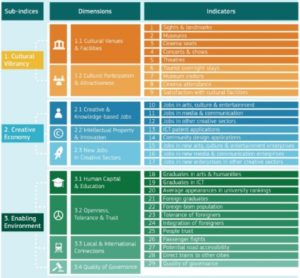Source: The Cultural and Creative Cities Monitor, European Commission.
A tool to promote mutual exchange and learning between cities to boost culture-led development
Developed by the European Commission through the Joint Research Center, The Cultural and Creative Cities Monitor has been launched in July 2017 and the updated data is available.
The Cultural and Creative Cities Monitor is designed to help national, regional and municipal policy makers identify local strengths and opportunities and benchmark their cities against similar urban centres using both quantitative and qualitative data. The Cultural and Creative Cities Monitor is thus an instrument to promote mutual exchange and learning between cities.

Why a Cultural and Creative Cities Monitor
Since the adoption of the first ‘European Agenda for Culture in a Globalising World’ (2007), culture has taken an increasingly prominent place in European Union policymaking. However, mapping cultural and creative assets and measuring their value and impact in a systematic and comparable way across Europe remains a challenge, with no shared definitions or metrics, particularly at city level. The European Commission’s science and knowledge service, the Joint Research Centre, has developed the Cultural and Creative Cities Monitor supports the European Commission’s efforts to put culture at the heart of its policy agenda. It provides comparable data on how European cities perform in the areas of culture and creativity, and how this performance relates to jobs, wealth and economic growth.
The Cultural and Creative Cities Monitor
The Cultural and Creative Cities Monitor is a new tool to monitor and assess the performance of ‘Cultural and Creative Cities’ in Europe vis-à-vis their peers using both quantitative and qualitative data.
This platform allows users to browse the 168 selected cities and the quantitative and qualitative information about their performance in the Countries and Cities pages. Its Creative Tools make it possible to adapt weights according to the importance attached to different topics by cities and produce customised rankings; create a new city entry, by adding new data, and to compare it to selected cities in the Monitor; and to simulate the impact of policy actions (e.g. increased city visitors) on the final scores, thus allowing users to build scenarios.
The quantitative information is captured in 29 indicators relevant to nine dimensions reflecting three major facets of the cultural, social and economic vitality of cities:
- Cultural Vibrancy measures the cultural ‘pulse’ of a city in terms of cultural infrastructure and participation in culture;
- Creative Economy captures how the cultural and creative sectors contribute to a city’s employment, job creation and innovative capacity;
- Enabling Environment identifies the tangible and intangible assets that help cities attract creative talent and stimulate cultural engagement.
The qualitative component includes key facts and manifestations of cities’ cultural and creative assets to illustrate and complement the quantitative evidence.
Cultural and Creative Cities Monitor’s conceptual framework and indicators

The Basque Country performance
This first edition of the Cultural and Creative Cities Monitor shows the performance of Bilbao and San Sebastian and their position compared to other European cities.
 See the Bilbao Overall Performance
See the Bilbao Overall Performance
 See the San Sebastian Overall Performance
See the San Sebastian Overall Performance
The Cultural and Creative Cities Monitor is available as an interactive online tool to allow users to browse the selected cities as well as a wide array of quantitative and qualitative information about their performance.
Further information is available at this link: The Cultural and Creative Cities Monitor
